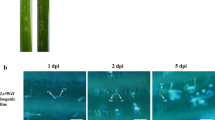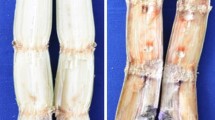Abstract
“Bainong 3217 × Mardler” BC5F4 wheat line at the initial stage of inoculation with powdery mildew pathogen (Erysiphe graminis DC) was used to construct a suppression subtractive hybridization (SSH) cDNA library. Totally 760 ESTs were obtained through sequencing. Similarity analysis of ESTs based on BLASTn and BLASTx with the sequences in GenBank, in combination with macroarray differential screening, revealed that 199 ESTs of 65 kinds were known to be functionally disease resistance related. Based on the gene expression profiling in the present study, it is postulated that salicylic acid (SA) and MAP-related signal transduction pathways were involved in powdery mildew resistance in wheat. System acquired resistance genes were predominant in terms of kinds and quantity. With the initiation of cell defense reaction, the genes conferring anti-oxidation substances were largely expressed and thus cell protection mechanism was activated. Much evidence revealed that phenylpropanes metabolic pathway was involved in phytoalexin synthesis in wheat powdery mildew resistance. Genes conferring some enzymes of structural modification of cell walls and proteinase inhibitors inhibiting pathogen growth were also detected. The genes controlling a few proteinases (mainly cysteine proteinase) had a considerable redundancy of expression.
Similar content being viewed by others
References
Schaffrath, U. F. E., Dudler, R., Evidence for different signaling pathways activated by inducers of acquired resistane in wheat, Mol. Plant-Microbe Interact., 1997, 10: 779.
Terryn, N., Rouze, P., von Montagu, M., Plant genomics, FEBS Letters, 1999, 452: 3.
Adams, M. D., Kelley, J. M., Gocayne, J. D. et al., Complementary DNA sequencing: Expressed sequence tags and human genome project, Science, 1991, 252: 1651.
Diatachenko, L., Lau, Y. F. C., Campbell, A. P. et al., Supression subtractive hybridization: A method for generating differentially regulated or tissue-specific cDNA probes and libraries, Proc. Natl. Sci. USA, 1996, 93: 6025.
Hofte, H., Desprez, T., Amselen, J. et al., An inventory of 1152 expressed sequence tags obtained by partial sequencing of cDNAs from Arabidopsis thaliana, The Plant Journal, 1993, 4(6): 1051.
Yammanoto, K., Sasaki, T., Large-scale EST sequencing in rice, Plant Molecular Biology, 1997, 35: 135.
Beavn, M., Bancroft, I., Bent, E. et al., Analysis of 1.9 MB of contigous sequence from chromosome 4 of Arabidopsis thaliana, Nature, 1998, 391: 485.
Franck, S., Dudler, R., Nucleotide sequence of a wheat cDNA encoding a putative pathogen-inducible protein homologous to PWIR1, Plant Physiol., 1995, 109: 338.
Gorlach, J., Volrath, S., Knauf-Beiter, G. et al., Benzothiadiazole a novel class of inducers of systemic acquired resistance, active gene expression and disease resistance in wheat, Plant Cell, 1996, 8: 629.
Schweizer, P., Hunziker, W., Mosinger, E., cDNA cloning in vitro transcription and partial sequence analysis of mRNA from winter wheat (Triticum aestivuml) with induced resistance to Erysiphe graminis f. sp.tritici, Plant. Mol. Biol., 1989, 12: 643.
Haizel, T., Merkle, T., Pay, A. et al., Related articles, protein, nucleotide characterization of proteins that interact with the GTP-bound form of the regulatory GTPase Ran in Arabidopsis, Plant J., 1997, 11(1): 93.
Machida, Y., Nishihama, R., Kitakura, S., Progress in studies of plant homologs of mitogen-activated protein (MAP) kinase and potential upstream component in kinase cascades, Critical Rev. Plant Sci., 1997, 16: 481.
Frye, C. A., Tang, D., Innes, R. W., Negative regulation of defense responses in plants by a conserved MAPKK kinase, Proc. Natl. Acad. Sci. USA, 2001, 98(1): 373.
Ikeda, Y., Koizumi, N., Kusano, T. et al., Related articles specific binding of a 14-3-3 protein to autophosphorylated WPK4, an SNF1-related wheat protein kinase, and to WPK4-phosphorylated nitrate reductase, J. Biol. Chem., 2000, 275(41): 31695.
Thomma, B. P. H. J., Eggermont, K., Penninckx, I. A. M. A. et al., Separate jasmonate-dependent and salicylate-dependent defenseresponse pathways in Arabidopsis are essential for resistance to distinct microbial pathogens, Proc. Natl. Acad. Sci. USA, 1998, 95(25): 15107.
Chen, W., Chao, G., Singh, K. B., The promoter of a H2O2-inducible, Arabidopsis glutathione S-transferase gene contains closely linked OBF- and OBP1-binding sites, Plant J., 1996, 10(6): 955.
Leon, J., Lawton, M. A., Raskin, I., Hydrogen peroxide stimulates salicylic acid biosynthesis in tobacco, Plant Physiol., 1995, 108: 1673.
Mur, L. A. J., Naycor, G., Warnor, S. A. J. et al., Salicylic acid potentiates defence gene expression in tissue exhibiting acquired resistance to pathogen attack, Plant J., 1996, 9: 559.
Hennig, J., Dewey, R. E., Cutt, J. R. et al., Pathogen, salicylic acid and developmental dependent expression of β -1,3-glucanase/GUS gene fusion in transgenic tobacco plants, Plant J., 1993, 4: 418.
Grayer, R. J., Kokubun, T., Plant-fungal interactions: The search for phytoalexins and other antifungal compounds from higher plants, Phytochemistry, 2001, 56(3): 253.
Dat, J., Vandenabeele, S., Vranova, E. et al., Dual action of the active oxygen species during plant stress responses, Cell Mol. Life Sci., 2000, 57(5): 779.
Casaretto, J. A., Corcuera, L. J., Plant proteinase inhibitors: A defensive response against insects, Biol. Res., 1995, 28(4): 239.
Author information
Authors and Affiliations
Corresponding author
About this article
Cite this article
Luo, M., Kong, X., Huo, N. et al. Gene expression profiling related to powdery mildew resistance in wheat with the method of suppression subtractive hybridization. Chin. Sci. Bull. 47, 1990–1994 (2002). https://doi.org/10.1360/02tb9432
Received:
Issue Date:
DOI: https://doi.org/10.1360/02tb9432




